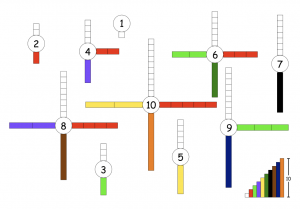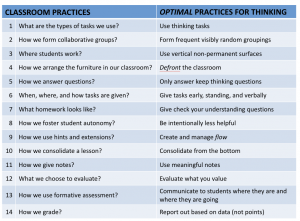A few weeks ago, I got a text from Fawn Nguyen asking if she could visit my school site and teach math lessons in a few different grade levels. She is now working for Amplify and no longer has regular opportunities to connect with kids and hone her practice of teaching mathematics. It was a gift to have her visit MUS yesterday and teach four different grade levels. She taught in 6th, 5th, Kindergarten, and a 2nd grade intervention group.
My day was full with so many takeaways. Here are a few that stood out:
- K can work for 60 minutes straight on an engaging tasks. Fawn sat down with a Kindergarten class and played the game of Nim with them. She adjusted the game to have 8 cubes which was much more accessible to younger children. She engaged the class by introducing Nim on the rug and then sent the students off in partners to play the game while she circled around asking the students questions while they played. Several times she brought the class back to the rug for a short 5 minute conversation and again sent them back to explore with a new prompt or focus. It was great to see her send the message starting in Kindergarten that math is about making sense of problems and figuring things out. The kids figured out important qualities about the game, such as “3 is a bad number” and why they want to go first and take 2 cubes. High level thinking is possible at Kindergarten when you create opportunities for it to happen.
- Struggle needs to be coached. I was observing a 5th grade class work on a challenging task involving fisherman taking a number of fish. 90% of the class quickly engaged in the task with very little guidance or knowledge of what to do. We promote and celebrate struggle in every subject at my school site and most students have a level of comfort engaging in a task when they don’t know what to do. A few students did not engage at first. I watched Mrs. N check in with one of the students and after a quick minute of coaching around the importance of of struggle this student felt safe and motivated to engage. He stayed engaged for the remainder of the lesson. He just needed a reminder that he was supposed to be struggling and off he went.
- Problem solving is about what you do, when you don’t know what to do. One of the teacher moves Fawn made during the 5th grade fisherman task was deciding when to pause the group work and give a nudge to get groups unstuck. While walking around and interacting with the groups of 3 who were working on vertical white boards, she realized that many groups did not know what strategy to use to solve this problem. She also noticed that one group started to use the strategy of working backwards. She got the classes attention and talked about the importance of problem solving strategies to help solve challenging problems. She then asked if any groups had a strategy they were trying and why the selected that strategy. After the one group shared why they chose to work backwards as their strategy, Fawn released the groups to keep going. The kids owned the learning but Fawn played a critical role in orchestrating the conversations and the learning.
- Thinking is engaging – Fawn played Catch-Up with a group of seven 2nd graders during their 30 minute pull out intervention. Catch-Up is a basic addition game filled with thinking and strategy. The kids were hooked. My intervention over the years have shifted to be based on games, problem solving, and mindset. The most significant data piece that this change has produced is the even the kids who are struggling the most with math, still love it and are engaged in learning it everyday. Math is really fun if you allow kids to own the learning and make sense of the math. It can be a beautiful and creative subject if filled with rich problem solving tasks and games.
- Observing is powerful. Thanks to Fawn visiting, I spent about 2 hours of my day just observing. I observed what moves Fawn made. I observed students working in groups. Most importantly, my focus was on observing to see how the kids responded to what Fawn did or did not do as opposed to when teaching, observing with a lens on how to move their thinking and mathematics forward.
- A rich task that is has a low floor and high ceiling can be engaging at a range of grade levels. I got to see Fawn use the same game of Catch-Up with a 2nd grade intervention group and with a whole class of 5th graders. They were equally engaged in the thinking. The game has opportunities for students to take it to different levels based upon their own thinking and readiness.
- This type of learning is really hard to understand when you have not experienced it. At a recent event a well intentioned parent asked if the problem with our math teaching is that we “play” to much and don’t do enough “brute” learning. I would argue the opposite is true. We don’t “play” enough in math. An untrained eye might walk in to one of Fawn’s lessons and see kids taking and playing while the teacher just walks around the room. It looks very unguided and messy. To a teacher trained to teach through inquiry and problem solving, a lot of purposeful magic is happening. Students are talking about their strategies and thinking. The teacher is purposely checking in with groups, checking for understanding, and determining what next step each group should take and what next step should the whole class take together. She is driving the class to a learning goal, all the while the students are making sense of the math they are learning and enjoying it at the same time. To shift to this type of teaching and learning, our teachers had to experience this pedagogy before they learned how to implement it in their classroom. We had opportunities for our school board members to visit classrooms while we pointed out the moves that the teachers were making, why they were making them, and how the kids responded to those moves. The significant jump in test scores over the next several years was the additional proof that a lot more than “play” was and still is happening. Although, if you ask one of the students, they might tell you that they are playing math, and that is 100% ok with me.





